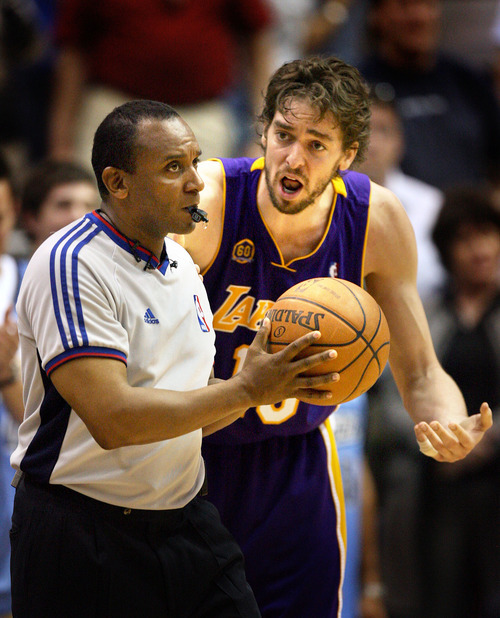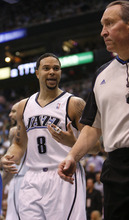This is an archived article that was published on sltrib.com in 2010, and information in the article may be outdated. It is provided only for personal research purposes and may not be reprinted.
After combing National Basketball Association data spanning 13 seasons, a Brigham Young University economist has concluded referees aren't completely color-blind in calling fouls. But while Joe Price's data might suggest refs are racially biased, he is more interested in what the findings say about how race unintentionally affects the way people make split-second evaluations of others.
"The other settings this type of bias can occur are much more important than in basketball: law enforcement, in the classroom, where it may determine who gets called on," said Price, who, along with University of Pennsylvania professor Justin Wolfers, published the report Friday in the Quarterly Journal of Economics. The economists say NBA data indicate referees are 4 percent less likely to call fouls on players of their own race. And players score 2.5 percent more points when facing referee crews of their own race.
"These biases are sufficiently large that they affect the outcome of an appreciable number of games," the scholars wrote.
Southern Utah University economics professor David Berri reviewed the Price-Wolfers study three years ago, when the research was made public, and says its conclusions are much broader than bias on the part of NBA refs.
"If you have to make a split-second decision, there are things getting in there that you wouldn't want in there. You can find this implicit bias across the population," said Berri, president of the North American Association of Sports Economists. "This clearly goes beyond the NBA. It's something every law enforcement officer needs to be aware of."
NBA spokesman Tim Frank declined to comment on the report and referred to the league's response when Price's research was first made public three years ago. At that time, the NBA commissioned its own study but found no evidence of bias, according to The New York Times. The newspaper then hired three scholars to compare the league results with the economists' work and found the Price-Wolfers report to be more reliable. SUU's Berri was one of those scholars.
"They went through the data and thought of different ways it could be processed and came up with the same result every time. That's a sign that something is going on," Berri said.
Price and Wolfers didn't set out to pick on professional basketball. The NBA just happens to maintain a rich set of data that is a boon to social science. Hundreds of players competed in thousands of games between 1991 and 2004, the seasons the economists analyzed, providing a vast sample and solid baselines.
"The evaluators in our sample [referees] are a particularly expert group, with substantial experience, continual feedback and large incentives to be accurate," wrote Price, who conducted the study while he was a doctoral student at Cornell University. Quoting NBA Commissioner David Stern, he notes that refs "are the most ranked, rated, reviewed, statistically analyzed and mentored group of employees of any company in any place in the world."
With all that accountability and stat-keeping imposed on individuals who cross paths again and again, NBA competition is a much better environment to detect racial bias than classrooms, police beats or managers' hiring decisions — arenas where such bias really matters in society.
"With all of those [other] decisions, we don't have good data on how they were made and they are not particularly well-monitored. Basketball is perfect," Price said. "You have excellent data on what is occurring, and the decisions are being made in front of thousands of people."
As a bonus to researchers, NBA refs are rotated around the league in a way that makes their pairings with any given team or other referees effectively random. The league maintains a staff of 60 each season, assigned to games in three-person crews. Staffing is structured to balance the referees' experience, and crews are reshuffled every few games to ensure that no single ref is assigned to the same team for more than nine games.
In addition to the differential in foul calling, the scholars found no single referee standing out as more biased or less biased, that the 4 percent differential held for technical and flagrant fouls, which are considered more subjective calls and that the coaches' race also seems to influence referees' calls.
University of Texas scholars applied Price's methodology to major league baseball, analyzing strike and ball calls by home-plate umpires, with the ultimate goal of applying lessons learned to discrimination in the workplace. Their report, which has been accepted for publication in the American Economic Review, found racial bias affects calls on one in 200 pitches, but the bias seems to disappear in higher-stakes situations, such as pitches that could end an at-bat.
"We show that discrimination is price-sensitive, so that making it more costly reduces its expression," wrote lead author Daniel Hamermesh.
Findings
BYU economist Joe Price analyzed 13 seasons' worth of NBA statistics and found that players get an edge with referees of the same race. White refs are 4 percent more likely to whistle black players for a foul, Price's report says. He doesn't believe the bias is intentional, but rather the result of subtle mental associations people fall back on when making snap judgments.





